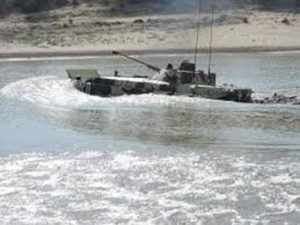Army Orders 12 Specialized Fast Patrol Boats For Pangong Tso
Januar 2, 2021
NEW DELHI: India has fast-tracked the order for a dozen specialized fast patrol boats, with advanced surveillance gear and other equipment, for patrolling the Pangong lake amidst the ongoing over eight-month long military confrontation with China in eastern Ladakh.

The Army inked the around Rs 65 crore contract for the 12 new patrol boats, with spares and maintenance for four years, with defence PSU Goa Shipyard on Thursday. “The deliveries of the boats will begin from May
this year. They will be deployed in Pangong Tso (Tso means lake), which is frozen at present,” said an officer.
The order for the boats is yet another indicator that the armed forces are preparing for the long haul in the confrontation with China. Indian and Chinese troops are currently locked in what is virtually an eyeball-toeyeball confrontation both on the north and south banks of the 134-km long Pangong Tso, two-thirds of which is controlled by China as it extends from Tibet to India.
The Army does have 17 QRT (quick-reaction team) boats for patrolling the Pangong Tso, which is located at an altitude of 13,900-feet, since 2012-2013. But the need was felt to further augment its capabilities to match the heavier Type-928B patrol boats being used by the People’s Liberation Army (PLA) there, as was reported by TOI earlier.
Both Indian and Chinese soldiers actively patrol their areas of Pangong Tso on foot as well as boats during the summer months. Before the Army got the QRT boats around eight years ago, it used to be quite hamstrung by its then outdated slow-moving boats. The PLA often used to even disable the Indian boats by ramming into them with its heavier boats.
Since early-May last year, the PLA has physically occupied the entire 8-km stretch from `Finger-4 to Finger- 8’ (mountainous spurs) on the north bank of Pangong Tso, taken control of the heights and built scores of new fortifications, bunkers and pill-boxes in the area.
After being caught off-guard by the PLA on the north bank of Pangong Tso, Indian troops carried out a proactive military manoeuvre to occupy the ridge line stretching from Thakung on the south bank to Gurung Hill, Spanggur Gap, Magar Hill, Mukhpari, Rezang La and Reqin La (Rechin mountain pass) on August 29-30.
These six to seven heights make it possible for Indian troops to oversee the PLA’s Moldo garrison, positions and roads, and have served as an “effective counter-pressure point” for leverage in the talks between the two countries.
China has been insisting that Indian troops should first withdraw from these heights on the south bank of Pangong Tso-Chushul area. India, in turn, has been demanding that any proposed disengagement should begin from the “Finger area” on the north bank of Pangong Tso.
The deadlock in talks is yet to be broken, with over 50,000 soldiers each from the two sides continuing to remain deployed all along the frontier despite freezing temperatures and oxygen deprivation in the high-altitude area. “The ninth round of corps commander-level talks is likely to take place in the coming days but the restoration of the status quo as it existed in April remains the bottom-line for us,” said an officer.
The eighth military round on November 6 had raised hopes of a de-escalation, with India and China broadly agreeing to a mutual pullback of troops, tanks and howitzers from the `friction points’ in the Pangong Tso-Chushul area. But the exact modalities and sequencing of steps, along with a joint verification mechanism, have not been finalized since then, as was reported by TOI earlier.
Courtesy: Opera News/TNN

